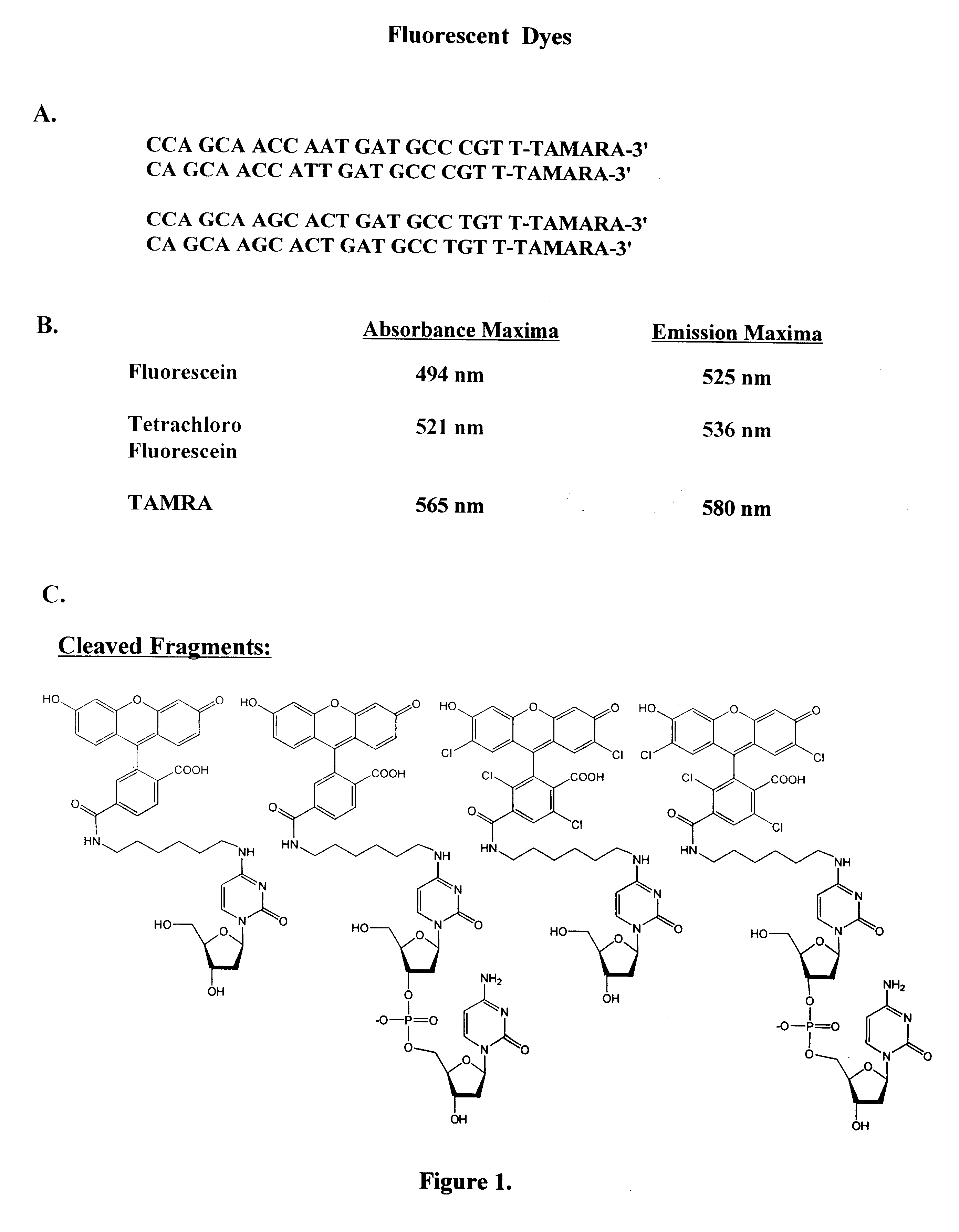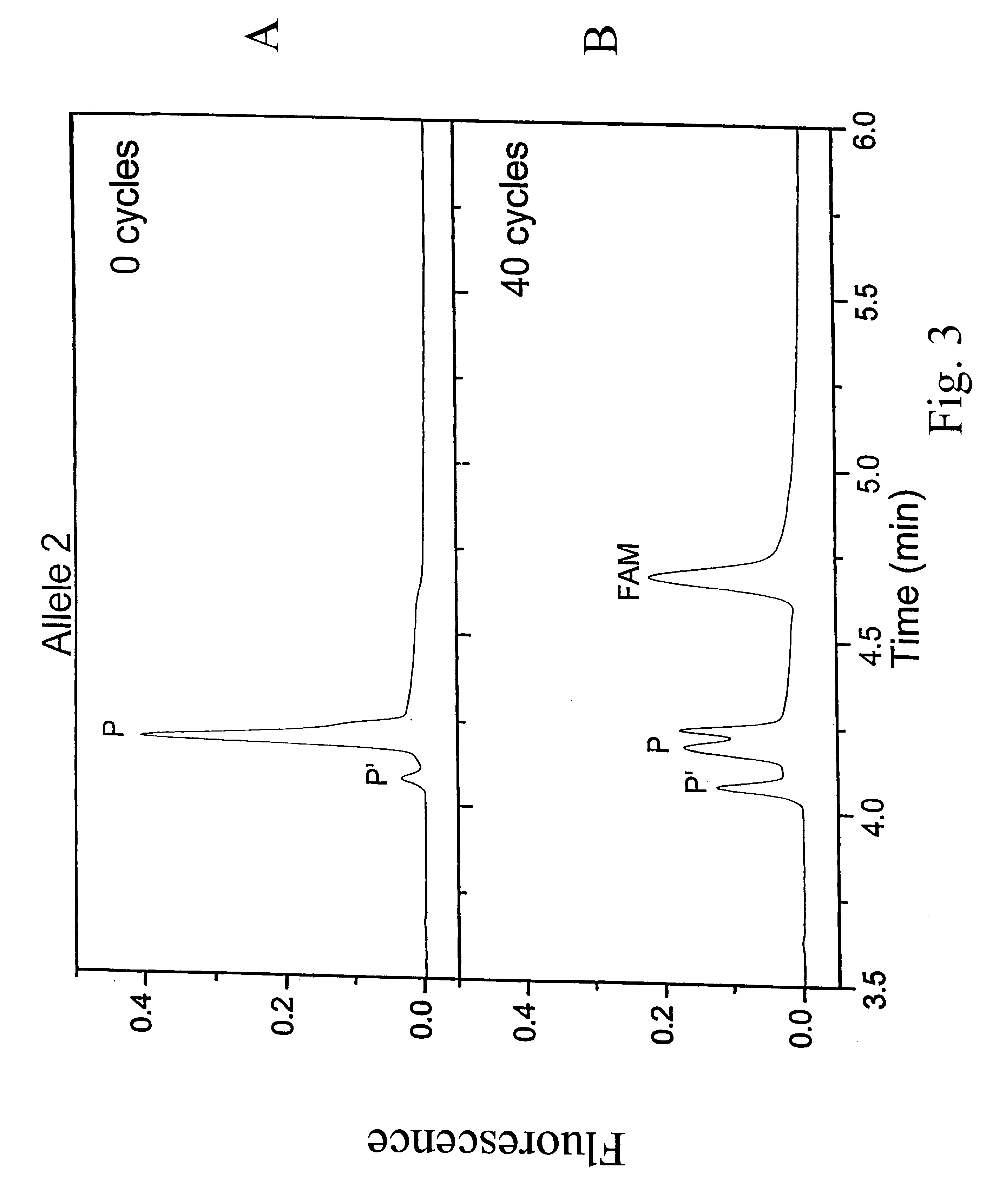Single nucleotide detection using degradation of a fluorescent sequence
a single nucleotide and fluorescent sequence technology, applied in the direction of fluid pressure measurement, liquid/fluent solid measurement, peptides, etc., can solve the problems of high cost of arrays and expensive synthesizing
- Summary
- Abstract
- Description
- Claims
- Application Information
AI Technical Summary
Problems solved by technology
Method used
Image
Examples
example 1
The experiment was set up to run in the following fashion (6 samples, a triplcate for Allele-1 and another triplicate for Allele-2)
22 .mu.l of Mastermix
13 .mu.l of probes and primers (both the probes are present)
4.0 .mu.l of Allele-1 or Allele-2
11 .mu.l of buffer (10 mM Tris-HCl, 1 mM EDTA, pH8.0)
The above volumes were added to a PCR tubes and the reaction mixtures were cycled in the following fashion for 40 cycles.
Initial Steps:
The reaction mixtures were kept at 50.degree. C. for 2 minutes for optimal AmpEmse UNG activity. The 10 minute, 95.degree. C. step was required to activate AmiphTaq Gold DNA Polmerase.
Each of the 40 cycles was performed on a Gene Amp .RTM. system 9600thermal cycler (Perkin Elmer) in the following fashion:
Results from experiments with Allele-1 are shown in FIG. 2. CE separation of the reaction products of Allele 1 after 0 and 40 cycles. CE instent was Beckma P / ACE 5000 with LIF detection. BGE: 2.5% LDD30, 7 M urea,. 1.times.TBE, Capillary: 100 .mu.m i.d., 375...
example 2
A Multiplexed Reaction With Both Allele 1 and Allele 2 Present In Equal Ratio
The experiment was set up in the following fashion (3 reaction tubes, a triplicate)
22 .mu.l of Mastermix
13 .mu.l of probes and primers (both of the probes were present)
4.0 .mu.l of Allele-1
4.0 .mu.l of Allele-2
7 .mu.l of buffer (10 mM Tris-HCl, 1 mM EDTA, pH8.0)
The above volumes were added to a PCR tubes and the reaction mixtures were cycled in the following fashion for 40 cycles.
Initial Steps:
The reaction mixtures are kept at 50.degree. C. for 2 minutes for optimal AmpErase UNG activity. The 10 minute, 95.degree. C. step is required to activate AmpliTaq Gold DNA Polymerase.
Each of the 40 cycles is performed in the following fashion
The results are shown in FIG. 4 CE separation of a 1:1 mixture of the 40 cycles products of Alleles 1 and 2. Experimental conditions were as given above for the experiments of FIG. 2.
example 3
A Multiplexed Reaction With Both Allele 1 and Allele 2: Allele 1 is 10 Times More Concentrated Than Allele 2.
The experiment was set up in the following fashion (3 reaction tubes, a triplicate)
22 .mu.l of Mastermix
13 .mu.l of probes and primers (both the probes were present)
5.0 .mu.l of Allele 1
0.5 .mu.l of Allele 2
9.5 .mu.l of buffer (10 mM Tris-HCl, 11 mM EDTA, pH8.0)
The above volumes were added to respective PCR tubes and the reaction mixtes were cycled in the following fashion for 40 cycles.
Intial Steps:
The reaction mixtures were kept at 50.degree. C. for 2 minutes for optimal AmpErase UNG activity.
The 10 minute 95.degree. C. step was required to activate AmtiTaq Gold DNA Polymerase.
Each of the 40 cycles is performed in the following fashion
The results are shown in FIG. 5. CE separation of a 1:10 mixture of the 40 cycles products of Alleles 1 and 2. Experimental conditions were as given for the ex periments of FIG. 2.
PUM
| Property | Measurement | Unit |
|---|---|---|
| charge/mass ratio | aaaaa | aaaaa |
| charge/mass ratio | aaaaa | aaaaa |
| temperature | aaaaa | aaaaa |
Abstract
Description
Claims
Application Information
 Login to View More
Login to View More - R&D
- Intellectual Property
- Life Sciences
- Materials
- Tech Scout
- Unparalleled Data Quality
- Higher Quality Content
- 60% Fewer Hallucinations
Browse by: Latest US Patents, China's latest patents, Technical Efficacy Thesaurus, Application Domain, Technology Topic, Popular Technical Reports.
© 2025 PatSnap. All rights reserved.Legal|Privacy policy|Modern Slavery Act Transparency Statement|Sitemap|About US| Contact US: help@patsnap.com



